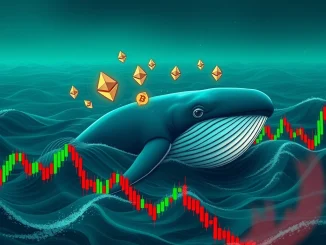
In the world of cryptocurrency, where fortunes are made and lost in moments, attention often turns to the major players and their strategies. Recently, a significant claim from FTX creditor representative Sunil Kavuri has sparked considerable discussion within the community. He suggests that the trading behavior of a prominent whale on the Hyperliquid platform, known as James Wynn, bears a striking resemblance to the methods employed by Alameda Research, the now-defunct sister company of the collapsed FTX exchange.
Why Compare James Wynn‘s Trading to Alameda Research?
The comparison to Alameda Research is notable because of Alameda’s history, particularly its close ties to FTX and its role in the exchange’s dramatic downfall. Alameda was known for its aggressive trading strategies, often involving large positions, complex derivatives, and significant market influence. The suggestion that another major trader’s activity mirrors this style raises questions and invites scrutiny.
According to Sunil Kavuri‘s statement on X (formerly Twitter), this comparison isn’t just based on observed trading patterns. Kavuri reportedly highlighted that James Wynn allegedly received payments from Alameda Research back in December 2020. While the nature or purpose of these payments wasn’t detailed in the initial claim, the mention of a financial link between Wynn and Alameda adds another layer to the comparison.
The Volatility of Hyperliquid Trading: A Case Study
Adding weight to the discussion about James Wynn‘s trading style is a report from blockchain analytics firm Lookonchain. This report previously detailed Wynn’s remarkable profitability followed by significant losses on the Hyperliquid trading platform.
- Lookonchain reported that Wynn accumulated over $87 million in profits within a period of just 70 days.
- However, this massive gain was reportedly followed by a near-total loss of those profits within a mere five days.
This kind of extreme volatility – rapid accumulation of wealth followed by swift, substantial losses – is characteristic of high-leverage, aggressive trading strategies, which were often associated with firms like Alameda Research. It underscores the inherent risks involved in such high-stakes market participation.
Implications for FTX Creditors and the Market
For FTX creditors, represented in part by individuals like Sunil Kavuri, any activity perceived as similar to Alameda’s past operations could be viewed with concern. Alameda’s trading activities and financial entanglement with FTX were central to the exchange’s collapse, leaving countless users and investors facing significant losses.
While a resemblance in trading style or past financial links doesn’t necessarily imply wrongdoing, Kavuri’s claim brings attention to large-scale trading activities on platforms like Hyperliquid and their potential impact on market dynamics. It also highlights the continued focus on figures and entities that had connections, direct or indirect, to the FTX/Alameda ecosystem.
Conclusion: Observing Market Dynamics
Sunil Kavuri’s assertion that James Wynn’s Hyperliquid trading resembles Alameda Research’s style, coupled with reports of Wynn’s volatile profit and loss history and past payments from Alameda, adds an intriguing element to the ongoing narrative surrounding major crypto traders and their impact. While the full context and implications of these claims remain subjects of discussion, they serve as a reminder of the complex and sometimes opaque nature of high-volume trading in the cryptocurrency market. Market participants and observers will likely continue to watch figures like James Wynn and platforms like Hyperliquid closely, especially in light of comparisons to entities like Alameda Research that played such a significant role in a pivotal moment in crypto history.



